The coronavirus pandemic has shrunk the farm-to-table restaurant channel as waiting lists build for CSAs; meanwhile, farmers markets tiptoe into the season, forcing organic farmers to pivot across markets. Here’s how several are meeting these new demands.
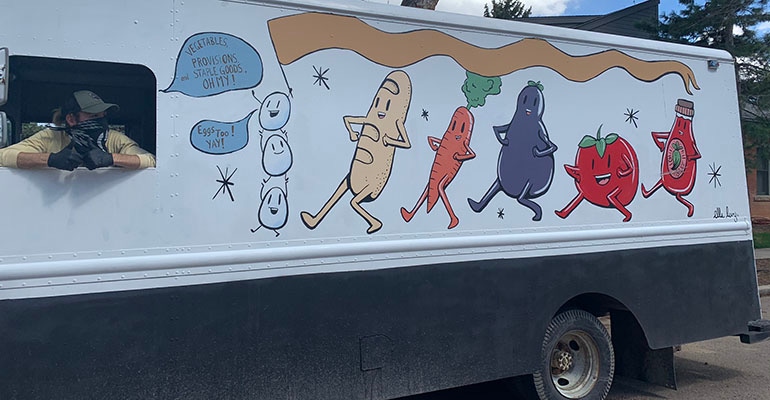
Dave Bishop laughs a little when he observes a fact about farming in the age of coronavirus.
“Social distancing?” he says, “that’s farming.”
Speaking from his PrairieErth Farm south of Peoria, Illinois, (pictured below) Bishop can afford to laugh, just a little.
He grows vegetables, lettuce, grains, beef and pork. He sells vegetables into a consumer-supported agriculture (CSA) program. He sells grain to an organic mill. Grocery stores near the farm and north into Chicago stock his produce. His restaurant client list has shrunk to the point of collapse, but the other legs on the multilegged stool that supports PrairieErth have held strong enough that the farm is in a good position. That’s because, he says, each of those legs is rooted locally.
 “All of the nonrestaurant accounts are expanding; people are ordering more, grocery stores are ordering more, the CSA home delivery model is going through the roof,” Bishop says.
“All of the nonrestaurant accounts are expanding; people are ordering more, grocery stores are ordering more, the CSA home delivery model is going through the roof,” Bishop says.
That local element, diversified production matched to a diversified roster of customers and perhaps a bit of halo shine from organic in a time of urgent health concerns, has left Bishop feeling relatively fortunate, he says. But he doesn’t have to look far past his fence line to see other farmers not so lucky.
“My conventional neighbors are the ones that really scare me,” he says. “I don't know how some of these larger farms, corn and soybean farmers, are going to survive.”
COVID-19 upended supply chains across innumerable industries, but given its integral and existential nature, the disruption of the American foodscape looms especially profound. A system honed to precision on efficiency does not quickly or easily reboot.
Seeking diversified markets
Eric Skokan can see across multiple points on a spectrum of farm diversification and efficiency. His 130-acre Black Cat Farm supplies his Black Cat restaurant. He raises chickens, turkeys, pigs and lamb. He also sells through a CSA and a farm stand and has a booth at the Boulder County Farmers Market. With the restaurant central to his business, he has had to pivot, and pivot hard, but he had some points to pivot toward as COVID-19 emerged.
“Organic is one of the great arrows in the quiver for these troubled times,” Skokan says, “but diversification is the other great arrow.”
Restaurants are not the only channel to suffer, however. Farmers markets are off to an unsteady start in some areas, beset by social distancing mandates and now also deprived of the social ambiance that is as much a part of the draw as the food in many communities. Schools and workplace cafeterias in areas where organic is prized are effectively gone.
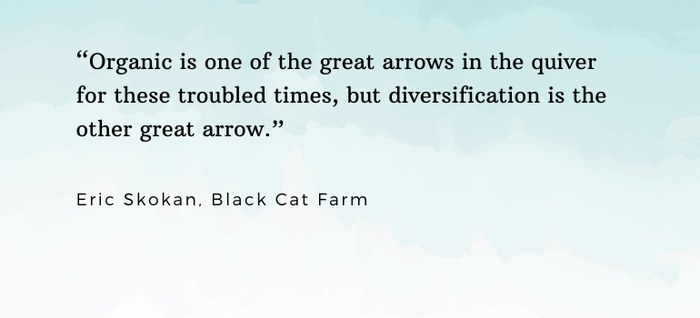
“Most of those accounts are dried up,” says Evan Wiig, communication director for the Community Alliance with Family Farmers, an agricultural advocacy program in Sonoma County, California. That’s left many farmers “scrambling,” he says. “They’re scrambling to figure out a new model. And one of the unfortunate things about agriculture, is that it’s harder to turn on a dime.”
Jumping from channel to channel, market to market, is harder than the non-farmer might expect. Creating a CSA means finding customers, finding packaging materials, developing a process to put the produce into those packaging materials, creating a delivery plan and then devising a system for taking payment. And that’s only possible if the farm has the diversity of products to make a CSA work. Nobody is signing up for an all-zucchini CSA.
Wiig spoke to one farmer who converted her acres to a few crops and then focused on the farmers market channel where shoppers can get rutabaga from one booth and walk a few booths down for broccoli or fruit.
“In other industries you can kind of switch things around and produce a little bit less of this a little bit more of that,” Wiig notes. “Farming is not that easy. You can’t simply go out into the field in and replant something that was supposed to have gone in a month ago.”
Innovating on the business model
Skokan calls himself blessed that he had the CSA and the Boulder County Farmers Market in his portfolio. The market, he says, stepped up and “on the fly” created an online ordering system for farmers. “The farmers market staff does the pick and pack,” he notes.
But with his restaurant closed except for takeout and delivery, he took the bold step of inventing a new market. A brightly painted truck he named “Mabel” now rotates through different neighborhoods. He compares it to an ice cream truck.
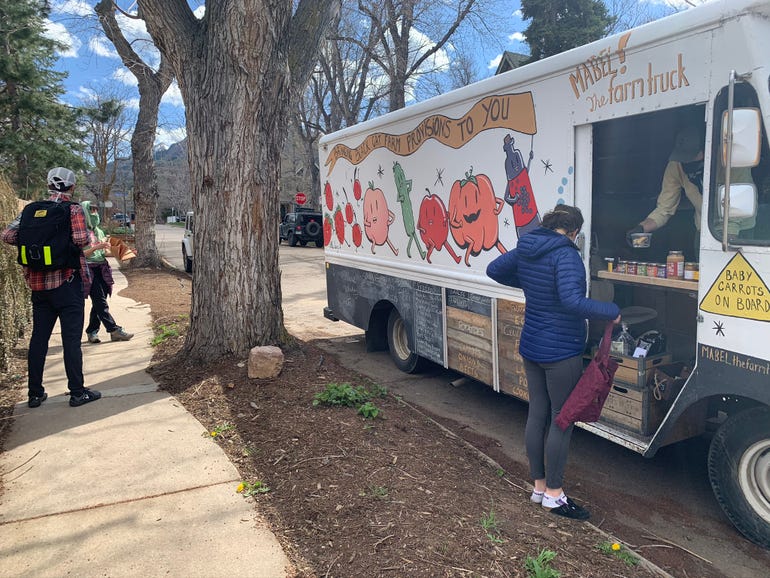
“It’s a really simple business idea: bring the organic produce to people’s front doors in a really fun, experiential way,” he says. “We all remember the ice cream man. We all love the ice cream man. But now the ice cream man sells carrots and arugula.”
Kansas farmer Clint Braeur had no idea what coronavirus was when he put together a program earlier this year that turned out to be a good fit for the pandemic era. The program invites nonfarmers to work the fields and greenhouses, learn some practical techniques and go home with vegetables. The farm environment makes social distancing easy and a nation cooped up inside on Zoom calls is eager to get their hands in the dirt, he says.
“We haven’t really marketed it, but it seems to be growing every week,” Braeur says. “They’re bringing more friends. More people are signing up and they’re coming out again. They’re getting two or three hours of exercise, and they’re going home with vegetables.”
Still, Wiig cautions such innovation doesn’t come naturally to many farmers who focus on production and not marketing. “The average age of farmers being 60 years old,” he says, “making that transition is not easy for everyone.”
Going beyond local
There are bigger issues in agriculture than farmers markets and CSAs could ever solve. The system could become more local, or at least more regional, but decades of ruthless efficiency have left American agriculture ill-prepared for radical disruption.
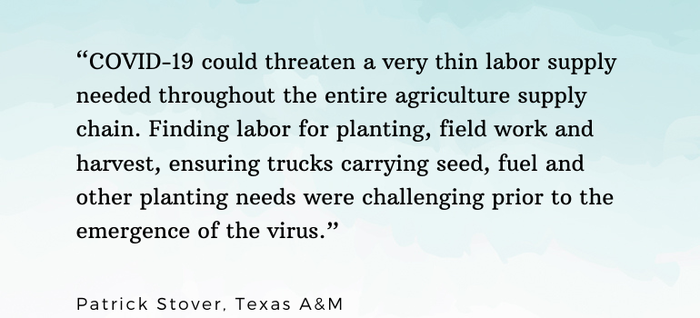
Patrick Stover, dean of agricultural and life sciences at Texas A&M, says some difficult challenges are inherent to the system as it exists.
“COVID-19 could threaten a very thin labor supply needed throughout the entire agriculture supply chain,” he wrote in an email response to questions. “Finding labor for planting, field work and harvest, ensuring trucks carrying seed, fuel and other planting needs were challenging prior to the emergence of the virus.”
There are also financial issues hovering around a system in which debt is a crushing fact of life for many farmers that are not going to be swept away in a relief package. “The lending sector has already been spooked by low returns over the past few years, and now planting time prices have pretty much cratered across the board,” writes Stover.
Farmers may be seeing more demand, but that doesn’t mean their incomes are unaffected by the pandemic. Nate Powell-Palm, who raises organic beef on his Montana ranch, explains that so many farmers have struggled for so long that almost all of them have taken on second jobs. Many of those employers are shuttered now.
“Most farmers either have an off-farm job themselves, or they have a spouse or family member with an off-farm job that keeps everything going,” Powell-Palm says. “With COVID, now you have both a depressed farm economy but also everybody else losing out on work.”
Like many farmers, Powell-Palm is watching the stimulus acts rolling out of Washington warily. If farming is essential, farmers should be treated as essential. More debt, he says, is not the answer.
“I don't think anyone in farming needs more credit right now. They really need sort of a direct payment.”
Andrew Pittz, who grows organic berries in western Iowa, says he would like to believe there is an opportunity for organic farmers to play a part in a healthier post-pandemic America, but it will take more than a changing consumer tastes to make that happen.
“It will be necessary for infrastructure to move in lockstep to meet food consumers where they are. Who knows what the new normal will be? And for how long? Organic producers and processors and brands will have to be ready to pivot accordingly to deliver on the promise of organic health.”
The industrial nature of modern agriculture is part of what led the food system into the ditch it finds itself stuck in. That drive toward efficiency locks in inertia that makes sudden course changes all but impossible. Skokan had his farm stand, his restaurant, his CSA, his farm booth and now a farm truck. That’s a rare situation. There are farmers with a single customer, he says.
“Those that are producers that are going to have the hardest time,” Skokan says.
Small farms and localized farm economies have a better chance to adapt. “It’s harder to turn a battleship than it is to turn a dinghy,” he says.
One of the dysfunctional roots of the problem, say many, is the conventional grocery store system. Shelves are empty while produce gets dumped because the lumbering procurement network fails to respond to the disappearance of the restaurant market. Bishop points to ironies obvious to any shopper following food headlines. “You have the grocery stores saying you’re limited to two gallons of milk, and outside milk farmers are dumping milk on the ground.”
For Wiig, the big picture task right now is advocating to make sure small farmers can find help in government recovery efforts. Then it will be teaching farmers to find it as they are busy navigating a transformed market. Small-business loans may not be a great fit for farmers, he says. “The way farm economies work and farm business structures work is a little different,” he says.
Taking care of the farmers
The weak links in the supply chain exposed by the COVID-19 pandemic are not the only weaknesses in the farm belt to become suddenly obvious, and those weakness will likely soon come to bear on the food system. Powell-Palm points to rural health care that was “gutted in the last three years” and could easily be overwhelmed when the pandemic creeps out of urban areas and into small towns. “There might be 25 beds in a given regional health care facility and if a single town gets sick it is suddenly over capacity,” Powell-Palm says.
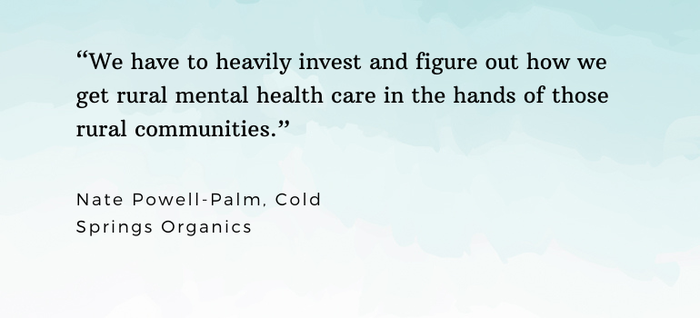
The bed-count in the clinics is not the only issue, he adds. Social distancing may be inherent to some agricultural activity—most tractors don’t have bench seats—but there is a social support system woven into farm communities that has been suddenly amputated. The pandemic might present a mental health risk that has gotten little attention. “You’re sort of isolated just by the nature of your work,” Powell-Palm explains. “Compound that with not really being able to see anybody, and honestly not having the resources to deal with it.”
“We have to heavily invest and figure out how we get rural mental health care in the hands of those rural communities,” he says.
Rick Carr, farm director at the organic agriculture research-focused Rodale Institute, says he sees that lack of community contact in areas built on community as a real risk. Many rural areas where he works in Pennsylvania were founded as religious communities and now the churches are closed. “They’re still working, but they may rely on each other. Farming is a community and so when you start restricting those kinds of activities, it will have an emotional toll.”
The effect of the pandemic on migrant communities is just beginning to get attention in areas where agriculture is reliant on migrant labor. COVID-19 could be disruptive in ways that are difficult to predict. Carr sees potential to introduce the general population to an agriculture reality they might not have expected.
“We have 12 million people who are employed,” he says. “Let’s put a shovel in their hands and get them back to work.”
Answering the wake-up calls
The pandemic has called up a deafening roar of wake-up calls around the globe, and many of them are rooted in the food system. A nation of shut-ins occasionally ordering takeout but likely eating at home far more than in recent decades has created a demand of its own, and panic-buying of certain items has led to the unlikely sight of runs on staples including beans and rice.
All of that almost certainly has more people thinking about what they eat, how they prepare it, where they get it and where it came from. Whether this new food consciousness translates into changed habits around purchase and consumption is difficult to predict.
Many farmers hope a better understanding of agriculture, especially local and organic agriculture, could be in the offing.
“It’s a great chance for them to get to know their farmers,” Brauer says. “I’ve been saying this for 10 years: the best thing you can do is get to know the person who’s raising at least part of your food.”
Nobody knows whether people will see the pandemic end and abandon whatever externally imposed deprivations they perceived. They might be lining up at the happy hour buffet the way they’re lining up to get into Kroger today.
Powell-Palm says it up to “the producers, the processors and the brand marketers” to “keep the conversation alive.” “Let’s not go back and make ourselves vulnerable again. Let’s really pursue a new reality that makes us more resilient,” he says.
Black Cat’s Skokan may or may not park Mabel the food truck when a “back to normal” moment arrives. Right now the straw-houses nature of the food system has been exposed.
“We have empty store shelves and piles of food discarded in the fields,” he says. “That’s the perfect sign of a machine that’s not resilient.”
Small farms, local farms and organic growers have a moment to prove their more resilient model, he says. New habits take time to form and lots of people have lots of time to form them.
“Wouldn’t it be great if there are enough customers out there who turn it into a family ritual to hop in the car and go out to the farm stand?”
It’s the kind of ritual Bishop would love to see. For him, the lesson of the pandemic is that the entire infrastructure needs to move more toward local. The holes in the system have been laid bare and consumers are paying attention in a way they never have before. There is a chance to show them what a more local food system could mean.
“If we were supplying 90% of the food, this would be no problem,” he says, referring to pandemic-driven disruption. “But we’re not. We have to scale up to the point where we are supplying the vast majority of the food. Then this kind of crisis wouldn’t have such an impact.”
Social distancing may be a part of farming, he would say, but it’s not the part farming should be playing in a healthy, resilient society.
About the Author(s)
You May Also Like




